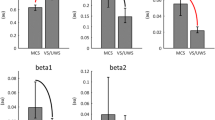Summary
A total of 187 psychomotor attacks in 78 epileptic patients were recorded on video band; 48 patients (61.5%) and 100 attacks (55.5%) showed signs of EEG flattening. This flattening became manifest before the clinical onset of the fit in 11.88% of patients, simultaneously with the fit in 30.5%, during the fit in 17.1%, and at the end of the attack in 4.8%. In 10.7% of the attacks, the flattening was considered as a cardinal EEG symptom of the fit, since it lasted longer than two-thirds of attack duration. Side differences in flattening occurred only in 6.4% of all attacks. The constancy of flattening varied in patients who had several attacks. Only few cases showed consistent flattening. In 50% of attacks with a remembered aura, the flattening occurred before the clinical signs of the fit. Since EEG flattening is explained by an arousal activation of the ascending reticular formation, it is assumed that the epileptic discharge of the psychomotor attack is initiated by activation of the nonspecific ascending reticular and limbic systems. This results in EEG flattening and clinically in an unconsciousness reaction.
Zusammenfassung
Von 78 Epilepsie-Patienten mit 187 im Doppelbild auf Videoband erfaßten psychomotorischen Anfällen zeigten 48 Patienten gleich 61,5% b/w. 100 Anfälle gleich 53,5% eine EEG-Abflachung. Die Abflachungen manifestierten sich vor klinischem Anfallsbeginn in 11,8%, mit Anfallsbeginn in 30,5%, im Anfallsverlauf in 17,1% und in 4,8% am Ende eines Anfalls. Eine Abflachung wurde dann als hirnelektrisches Kardinal-symptom eines Anfalls angesehen, wenn diese länger als 2/3 der gesamten Anfallszeit dauerte. Dies war bei 10,7% der Fall. Abflachungen mit Seitendifferenzen waren nur in 6,4% sämtlicher Anfälle nachweisbar. Die Konstanz der Abflachung ist bei den einzelnen Patienten mit mehreren Anfällen sehr unterschiedlich. Nur wenige Fälle zeigten immer eine Abflachung. Bei 50% der mit einer Aura einhergehenden Anfälle war eine Abflachung vor klinisch nachweisbarem Anfall feststellbar. Obwohl die Aktivierung des aufsteigenden reticulären Systems als Weckreaktion aufgefaßt wird, führt der einem psychomotorischen Anfall zugrunde liegende epileptische Prozeß wahrscheinlich über das unspezifische aufsteigende reticuläre und das limbische System mit der hirnelektrischen Abflachung klinisch zu einer Bewußtlosigkeit, somit zu einer „unconsciousness-reaction“.
Similar content being viewed by others
Literatur
Adrian, E. D., Matthews, B. H. C.: The Berger rhythm. Potential changes from the occipital lobes in man. Brain 57, 356–385 (1934)
Ajmone-Marsan, C., Ralston, B. L.: The Epileptic Seizure — Its functional Morphology and Diagnostic Significance, A Clinical-electrographic Analysis of Metrazolinduced attacks. Springfield-Illinois: Thomas 1957
Berger, H.: Über das Elektrenkephalogramm des Menschen. 2. Mittlg. J. Psychol. Neurol. (Lpz.) 40, 160–179 (1930)
Christian, W.: Klinische Elektroenzephalographie. Stuttgart: Thieme 1968
Creutzfeldt, O. D.: Neurophysiologische Modelle der Epilepsie. Nervenarzt 43, 175–181 (1972)
Dreyer, R., Wehmeyer, W.: Status mit psychomotorischen Anfällen. Beitrag zur klinischen und hirnelektrischen Problematik. Nervenarzt 48, 612–620 (1977)
Dreyer, R., Wehmeyer, W.: Fits of Laughter (Gelastic Epilepsy) with a Tumor of the Floor of the Third Ventricle. Neurol. 214, 163–171 (1977)
Dusser de Barenne, J. G., McCulloch, W. S.: Suppression of motor responses upon stimulation of area 4–5 of the cerebral cortex. Amer. J. Physiol. 126, 482 (1939)
Forster, F. M., Huertas, J.: Temporal Lobe Suppressor Cortex In Man. Yale J. Neurol. Medic. 28, 265–272 (1955/6)
Gastaut, H.: So-called „psychomotor“ and „temporal“ epilepsy. A critical study. Epilepsia (Boston) 2, 59–76 (1953)
Hill, D.: The electroencephalographic concept of psychomotor epilepsy: A summary. IV. Congr. Neurol. Internat. (Paris) 1, 27 (1949)
Janz, D.: Die Epilepsien. Stuttgart: Thieme 1969
Jasper, H. H., Daly, D.: Suppression of the Electroencephalogram During the Onset of an Epileptic Seizure. Proc. amer. Soc. Encephalogr. June 1947
Jasper, H. H., Pertuisset, B., Flanigin, H.: EEG and cortical electrograms in patients with temporal lobe seizures. Arch. Neurol. Psychiat. (Chicago) 65, 272–290 (1951)
Jovanovic, U. J.: Psychomotor Epilepsy. A Polydimensional Study. Springfield-Illinois: Thomas 1974
Jung, R.: Neurophysiologie u. Psychiatrie. In: Psychiatrie der Gegenwart, Bd. I/1 A Teil A, 325–928, J. C., Brengelmann, K. Conrad, J. Elkes, R. Hassler, R. Jung, G. Peters, E. Strömgren (Eds.). Berlin-Heidelberg-New York: Springer 1967
Karbowski, K., Pavlincova, E., Robert, F.: EEG-Ableitung im psychomotorischen Anfall. Z. EEG-EMG 3, 149–157 (1970)
Karbowski, K.: Das Elektroenzephalogramm im epileptischen Anfall. Bern-Stuttgart-Wien: Huber 1975
Landolt, H.: Die Temporallappenepilepsie und ihre Psychopathologie. Basel-New York: Karger 1960
Matsumoto, H., Ajmone-Marsan, C.: Cellular mechanisms in experimental epileptic seizures. Science 144, 193–194 (1964)
Kruse, R.: Anfallskrankheiten. In: Neuropädiatrie 23, 353–440. A. Matthes, R. Kruse (Eds.). Stuttgart: Thieme 1973
Mazars, Y.: Interprétation du phénomène d'extinction dans la phase initiale des crises focales corticales. Electroenceph. clin. Neurophysiol. 82, 520–522 (1950)
Meyer-Mickeleit, R.: Über die sogenannten psychomotorischen Anfälle, die Dämmerattacken der Epileptiker. Arch. Psychiat. Nervenkr. 184, 271–272 (1950)
Meyer-Mickeleit, R.: Die Dämmerattacken als charakteristischer Anfallstyp der temporalen Epilepsie (Psychomotorische Anfälle, Äquivalente, Automatismen). Nervenarzt 24, 331–346 (1953)
Moruzzi, G., Magoun, H. W.: Brain stem reticular formation and activation of the EEG. Electroenceph. clin. Neurophysiol. 1, 455–473 (1949)
Schorsch, G., v. Hedenström, I.: Die Schwankungsbreite hirnelektrischer Erregbarkeit in ihrer Beziehung zu epileptischen Anfällen und Verstimmungszuständen. Arch. Psychiat. Neurol. 195, 393–407 (1957)
Wehmeyer, W., Dreyer, R.: Praktische Erfahrungen beim Aufbau und mit der alltäglichen betrieblichen Handhabung epileptischer Reaktionen mittels Doppelbildverfahren (I). Medizinal-Markt 22, 4–7 (1974)
Wehmeyer, W., Dreyer, R.: Praktische Nutzbarkeit einer Fernseh-EEG-Abteilung für Forschung und Klinik. Z. EEG-EMG 7, 34–37 (1976)
Author information
Authors and Affiliations
Additional information
Mit Unterstützung der Deutschen Forschungsgemeinschaft
Rights and permissions
About this article
Cite this article
Dreyer, R., Wehmeyer, W. Die EEG-Abflachung bei psychomotorischen Anfällen, ihre Häufigkeit, Dauer, Form und Bedeutung. Arch. Psychiat. Nervenkr. 225, 263–274 (1978). https://doi.org/10.1007/BF00344013
Received:
Issue Date:
DOI: https://doi.org/10.1007/BF00344013




